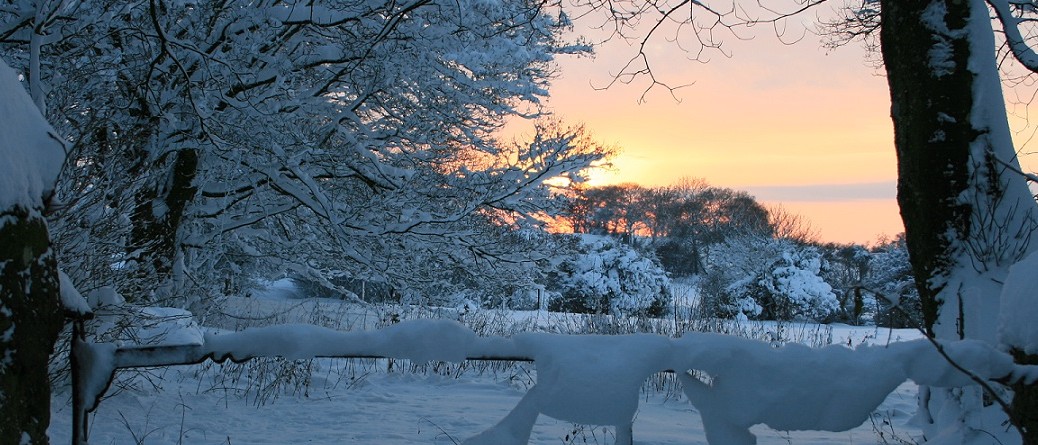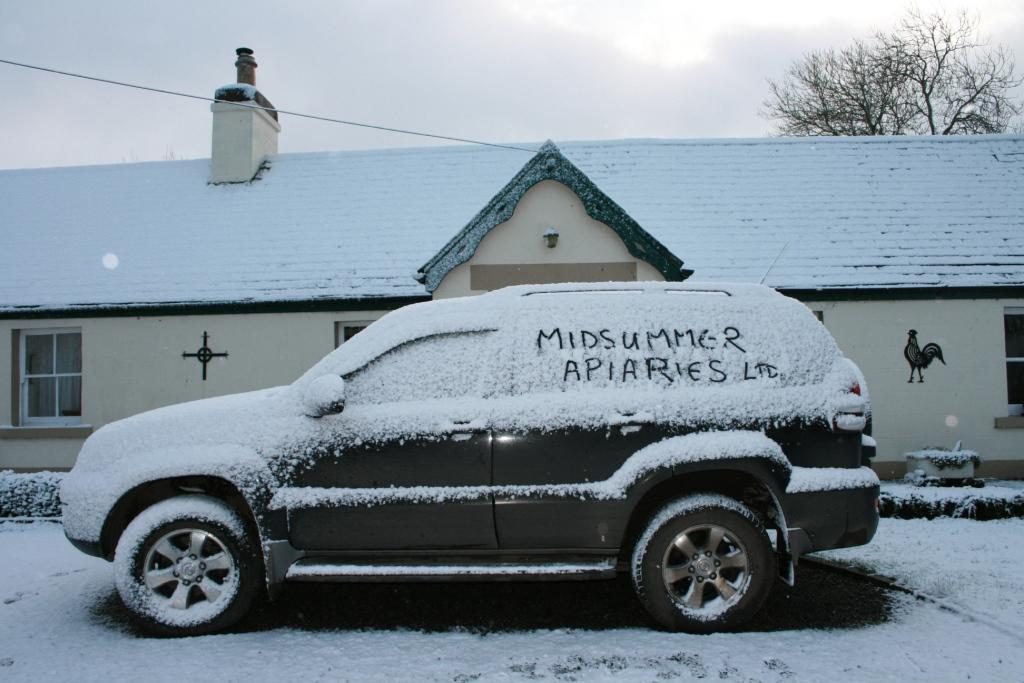This is a picture of Home in the deep mid-winter of 2011 when we had temperatures of minus 18!
It was amazing, we had icicles 2 ft long hanging from the gutters and because we had insulated the loft, even the water tank froze. We had to open the loft hatch and let the warm air up to thaw it out. Unfortunately it also loosened the snow on the roof which then slid off in sheets taking the gutters and the icicles with it.
I started beekeeping in 2001 with two hives and I now work 40 – 50 colonies of dark Irish bees. They were swarmy and some of them can still be a bit bad tempered when they have honey on board but they improve year on year. The improvement work continues – watch this space, or more specifically the page entitled ‘Native Bee’. Also the post on the Irish Native Bee which has links to several bee improvement articles.
Together we make a ‘small country living’ from the sale of bees, skeps, honey and beeswax and associated cottage-industry products such as candles, polish etc all sold locally.
During those years I’ve accumulated a lot of ‘stuff’ and rather than it sit here in my head or on this computer I may as well put it up here where it might be useful.
The other pages are of things I think are important – today – that might change tomorrow.


I love your writing style and honest comments.
Thank you for your well written and very informative blog. I found it while searching for information on making skeps. The last time I made one was about 45 years ago. I think I “lent” it someone, at the time, to be used as part of a beekeeping display, and “that was that” as we say, no more skep.
I’ve recently started volunteering on a historical colonial plantation near Dover, Delaware. The care takers would like to set up a “period correct apiary” for the site. So that means Skeps are needed. It gets better. They were happy to report
that they already have honey bees presently housed in a tree on site. I just have to move the bees to their new home, from the tree, which can not be removed or damaged in any way. Its as easy as that. Luckily I’ve been keeping bees since I was 17, taught by great uncle in the ’60s, worked as Delaware’s first full time inspector in the ’70s so I know how to get the bees out with damage I just need to make a SKEP. By the by these bees are the Blackest I’ve seen in a long time. I also liked your information on the Irish Honeybees.
Thanks again,
Phil
So, I’m fascinated – how you are going to conjure those bees out of the tree and into the skep?
I’d say making the skep would be the easy bit.
Thank you for a wonderful site. I am just about to embark on the road of Bee Keeping and was really interested to read all of your insightful information. Your images are amazing and the info is really helpful.
Thank you and best wishes.
Darragh
Thank you Darragh – that makes it all worth while!
One of the best sites i have found. Smart and well thought out with great info. THANKS!
my own bees died out with varroa a good few years back now, i did not know what it was at the time. but there is a wild colony thriving in a flat roof in a neighbours house, it has been there for years, at least fifteen i would think, i think they are native bees, small and black, like my own. have they developed immunity to disease?
Hello Joe and thank you for your comment.
It is possible that the wild bees have developed Varroa resistance but it would be difficult to test them while they are in the roof.
It is also possible that the colony died out several times during the 15 years and has been restocked by swarms from neighbouring beekeepers. Are there other beekeepers nearby?
I don’t expect it would be possible to get them out of the roof without a struggle either?
Hi Very interesting blog I am a beekeeper myself with around 30 hives.
Morning Jeff and thanks for the feedback.
Thanks, very clear and informative. Wishing you all a good season!
Thank you for your feedback. Let’s hope this year is as good as last year!